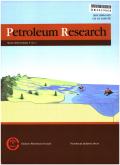Hydrocarbon generation potential of South Geisum Oilfield, Gulf of Suez, Egypt: Source rock evaluation and basin modeling for unconventional hydrocarbon prospects
IF 4
Q1 Earth and Planetary Sciences
引用次数: 0
Abstract
This study aims to define the hydrocarbon generation potential of source rocks by assessing various factors including quantity of organic matter, types of kerogen, thermal maturity, and source of organic matter input. Depositional conditions of source rocks from Thebes, Brown Limestone, and Matulla formations in Well G-9, Well GA-2 and Well GW-6, are assessed through pyrolysis, vitrinite reflectance and 1D basin modeling. Results show the source rocks of Thebes and Brown Limestone formations exhibit favorable to excellent source rock characteristics with Type I–II kerogen and have the capacity to generate oil. Conversely, the source rocks of the Matulla Formation show fair to good source rock characteristics with Type II–III kerogen and have the capacity to produce both oil and gas. Thermal maturity shows the source rocks are at an immature stage. A 1D basin model is constructed for Well G-9 to simulate multi-tectonic episodes, burial events, and the history of thermal maturity. Sedimentation rates of Cretaceous to Eocene deposits are characterized by a low burial rate, which contrasts with the high burial and sedimentation rates for Miocene and post Miocene (Pliocene–Recent) strata. Overall, the South Geisum oilfield petroleum system is found to be immature based on integration of source rock evaluation and petroleum basin modelling.
埃及苏伊斯湾南盖苏姆油田生烃潜力:烃源岩评价与非常规油气远景盆地模拟
通过评价有机质含量、干酪根类型、热成熟度、有机质输入来源等因素,确定烃源岩的生烃潜力。通过热裂解、镜质组反射率和1D盆地模拟,评价了G-9井、GA-2井和GW-6井底比斯组、棕灰岩组和Matulla组烃源岩的沉积条件。结果表明:底比斯组和棕灰岩组烃源岩具有良好的ⅰ-ⅱ型烃源岩特征,具有生油能力;马图拉组烃源岩特征较好,干酪根类型为ⅱ~ⅲ型,具有油气双产能力。热成熟度表明烃源岩处于未成熟阶段。G-9井建立了一维盆地模型,模拟了多构造期次、埋藏事件和热成熟度历史。白垩纪至始新世沉积速率具有低埋藏速率的特点,而中新世及后中新世(上新世—近世)地层则具有较高的埋藏和沉积速率。综合烃源岩评价和油气盆地模拟,认为南盖逊油田油气系统发育不成熟。
本文章由计算机程序翻译,如有差异,请以英文原文为准。
求助全文
约1分钟内获得全文
求助全文
来源期刊

Petroleum Research
Earth and Planetary Sciences-Geology
CiteScore
7.10
自引率
0.00%
发文量
90
审稿时长
35 weeks
 求助内容:
求助内容: 应助结果提醒方式:
应助结果提醒方式:


